The Great Depression & WW II
The decades of 1930 and 1940 represented some of the most dramatic changes in people’s lives in the history of Tennessee and the nation.
The decades began with the Great Depression , moved into a worldwide war, and ended with the beginning of the most prosperous era the country has ever known.
With the Depression, Americans experienced a complete change in their attitudes towards governmental involvement in their lives. People turned to the federal government to create jobs, improve lives, regulate businesses, and provide security for old age.
When World War II began, and ironically put a end to the Depression, people joined together for the war effort. Men and women joined the armed forces or related organizations to fight for their country.
With the creation of 17 million new jobs during World War II, there was plenty of work for everyone who wanted a job. Women took jobs in war-related industries. African Americans could find work in factories. A secret city was built in Oak Ridge to process radioactive materials to be used in an atomic bomb. It employed thousands.
Americans at home did their part for the war effort. They took part in scrap drives, bought war bonds, grew vegetables in Victory Gardens, and used ration cards. School children also participated. They could buy stamps and when they filled their books, turn them in for a war bond.
At the end of the war, Americans had regained their optimism about their future and their country’s future. As other Americans, Tennesseans came back from the war ready to enjoy the world that they had fought to keep safe.
Teacher's Page
Picture Credits:
- Photograph of a young girl holding home-canned goods in her family’s home. Franklin D. Roosevelt Library and Museum. Website hosted by Marist College. www.fdrlibrary.org.
- Photograph of a Tennessee family sitting in front of their fireplace in 1933. They are identified as the Oscar Cloud family, living in the Norris Dam town site area. The caption said that one son works with the Civilian Conservation Corps while the other hopes to have a job with the Tennessee Valley Authority (TVA). The photograph was taken by Lewis Hine who was hired by TVA to document life in the Tennessee valley before Norris Dam was completed. National Archives and Records Administration
- Photograph of a family’s crude lean-to in a field in West Tennessee in 1936. Photographer was Carl Mydans, who worked on New Deal projects. Library of Congress
- Photograph of the Douglas Dam construction in the early 1940s. Color photography was beginning to be used during this time. Tennessee Valley Authority. Library of Congress
- Photograph with the caption, “stranded in the location of the Old Congress Mine,” shows three young children sitting on the front steps of a dilapidated house. It is dated ca. 1942 and identified as from Tennessee. Franklin D. Roosevelt Presidential Library
- Two women are shown capping tubing that is used in the "Vengeance" dive bomber made at Vultee's Nashville plant. Photo was taken by Alfred Palmer in 1943. U.S. Office of War Information transferred to Library of Congress
- A soldier talks on a field telephone at a command post. Courtesy of the University of Tennessee Special Collections
- A soldier checks his bags at the Knoxville bus depot before taking a bus to Washington D.C. The photograph was taken by Esther Bubley in 1943. Office of War Information transferred to the Library of Congress
- Eating on the way took on new meaning during the war. Instead of stopping at restaurants, soldiers typically just stopped along the road. T-5s Herman Hoover, Beech Grove, TN, and Tollie Slocum, New River, TN, eat along the roadside somewhere in Europe. Both men were members of the Sixth Cav. Recon. Squad. Photo by PFC Howard James with the U.S. Army Signal Corps. Tennessee State Museum Collection
- Residents of Oak Ridge, Tennessee, celebrate the end of World War II. The research facility at this city was one of three sites responsible for the development of the atomic bomb. Office of Public Information, U.S. Department of Energy
Acknowledgments:
The Great Depression & WW II >>
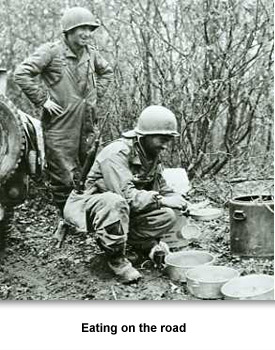
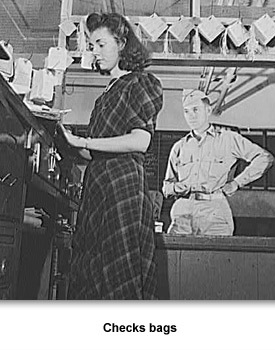
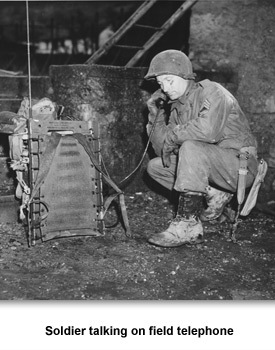

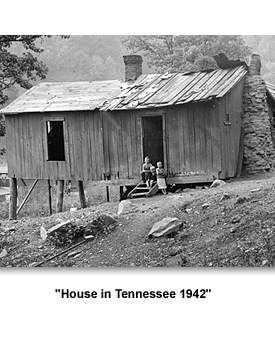

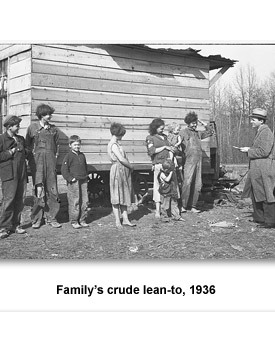
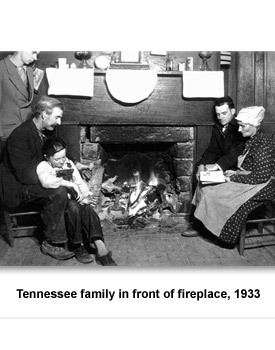


 Sponsored by: National Endowment for the Humanities
Sponsored by: National Endowment for the Humanities